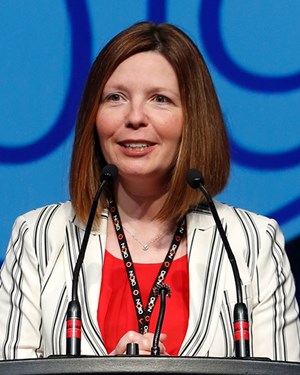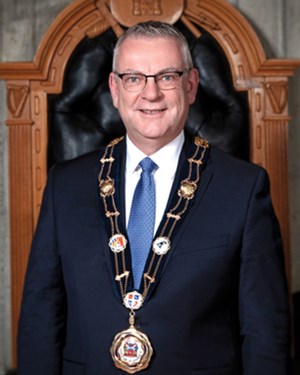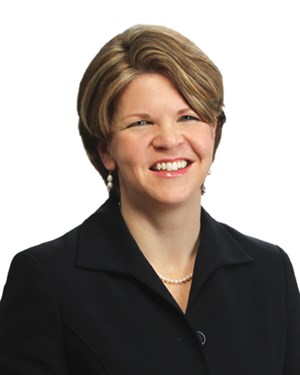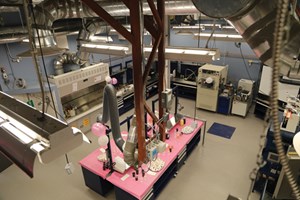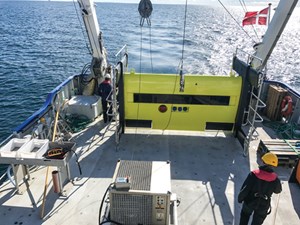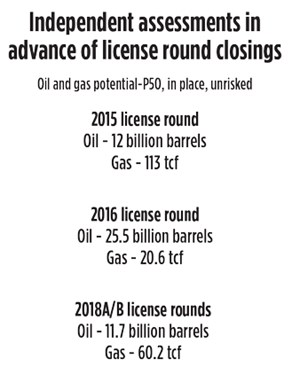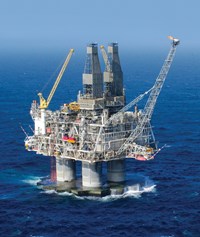Innovation continues to pull Newfoundland and Labrador’s offshore sector forward
As the oil and gas sector offshore Newfoundland and Labrador (NL) grows steadily, the province continues to excel in technical innovation by its companies. “There are challenges in our oil industry, and there’s a lot of innovative entrepreneurs with technological solutions to our challenges,” said Charlene Johnson, president of the Newfoundland & Labrador Oil and Gas Industries Association (Noia), Fig. 1.
On the activity side, there is considerable optimism. “I think it’s going to be an exciting time ahead—we have 10 exploration wells that are filed and going through environmental review,” said Johnson. “The next several years are very bright on the exploration front,” added Paul Barnes, director, Atlantic Canada and Arctic, for the Canadian Association of Petroleum Producers (CAPP). “And, of course, everyone’s waiting on the final development decision from Equinor.”
The only thing tempering enthusiasm is the passage in June of two controversial bills—C-69 (changing “environmental assessments” to broader “impact assessments”) and C-48 (Oil Tanker Moratorium Act—banning tanker traffic off a portion of Canada’s West Coast)—by Canada’s Parliament. “The issue with bill C-69 going forward is: will we (NL) still get that level of attraction, given the prospectivity that we have,” said Johnson. “We have the rocks, we’ve done everything we can, as a province, to reduce the underground risk. It’s the above-ground risk that we’re dealing with, and all of these uncertain regulations.”
CITY OF ST. JOHN’S
Offshore E&P remains perhaps the most important industry to the city of St. John’s. “Our GDP for the St. John’s CMA is expected to rise about 7.1% next year,” said Mayor Danny Breen, Fig. 2. “Much of that has to do with the increased capital investment in Husky’s West White Rose project. It makes a big difference to our economy. There’s around 5,600–5,700 direct jobs related to the offshore in the province.”
The industry’s importance to the city can be measured in other ways. “It’s good employment—the spin-off and contractor work here is significant,” continued Breen. “If you look at how these companies become part of the community, they become a part of the fabric of St. John’s, supporting the arts, sports or various community initiatives.” And, in turn, St. John’s over the years has been a great place for incubating new offshore companies. “We have the ability here to have so much knowledge, and to be in such a small place, where everybody knows everybody, you can take advantage to become very nimble in developing this type of business,” said the mayor.
OCEAN SUPERCLUSTER
In May 2017, the Canadian federal government created the C$950-million (US$721-million) Innovation Supercluster Initiative, to “create more middle-class jobs and more opportunities for Canadian businesses to grow into globally successful brands.” Accordingly, officials divided this effort into five “Superclusters,” to focus on specific portions of Canada’s economy, one of which is the Ocean Supercluster (OSC), based in Atlantic Canada. The OSC will harness emerging technologies to strengthen Canada’s ocean industries. Officials hope that it will have a 10-year GDP impact of more than C$14 billion and create 3,000+ jobs. In fall 2018, OSC’s Interim Steering Group hired Kendra MacDonald (Fig. 3) as permanent CEO.
MacDonald has accomplished much in a short time. “Part of this program’s beauty or design is that it is a 50-50 match between industry dollars and government dollars,” explained MacDonald. “And it’s meant to be industry-led. So, where does the industry want to invest their dollars? And how does the government help to de-risk those innovation investments? The real business case for the OSC was this idea of cross-sectoral collaboration, especially when you’re dealing with digital.”
Nevertheless, “it was over a year to get all the ducks in a row, to be able to get federal government funding flowing to projects,” said MacDonald. She said that a handful of projects are in a form of qualification round, early-stage. “We’re still evolving our processes, so I expect that we’ll have more feedback on those proposals,” continued MacDonald. “Our hope is that once we get through this handful, and we get more financial templates and eligibility-of-expense guidelines, that we will get more ideas coming through.”
MacDonald got the first OSC project approved on June 28, when the first Technology Leadership Project was announced. The OceanVision project is led by Kraken Robotics, a St. John’s-based marine technology company, to develop an underwater technology service hub that provides high-resolution images of the seafloor to a variety of ocean industries.
NATI
The Newfoundland and Labrador Association of Technology and Innovation (NATI) represents the province’s technology and innovation sector. “Yes, oil-and-gas is our biggest sector, but technology represents a huge opportunity, in terms of growth potential,” said CEO Paul Preston. “The tech sector here is bigger than the fishery, forestry or tourism. We really focus on a couple of key areas—advocacy is part of what we do, including calls to government for focus, attention and investment.”
Another part of NATI’s job is to help companies scale and grow. “We create new possibilities through technology and innovation, across sectors,” said Preston. “Accordingly, talent development is important—we need more people here, in tech careers.”
In addition, NATI and Noia entered into a tech/oil-and-gas partnership, creating the Digital Transformation Working Group, said Preston. “Over a year. they did a lot of research, including surveys, meeting with operators, and interviews. The key focus was where are there gaps and opportunities, and where can technology help digitalization of oil and gas.” The group issued a report at Noia’s conference in June, laying out four recommendations on jump-starting the digital transformation process.
Together, NATI and Noia also hosted NL’s first-ever Oil and Gas Hackathon weekend (Fig. 4) in early June. A hackathon can be described as an intensive, several-day, collaborative event among technical people. Operators and industry helped define the hackathon challenges, which were tackled with prototyped solutions developed by the three top teams. The event drew 115 registrants, who formed nine teams, which pitched their solutions to industry after 72 hrs of collaboration. With the support of mentors over the weekend, the groups presented practical solutions that could be implemented in industry.
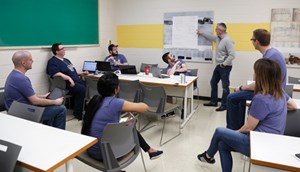
The winning hackathon team, Staycer, had this as their tagline: “Staycer is creating an online platform for offshore oil & gas operators and service providers that allows them to streamline approval processes by managing personnel training certifications.” Basically, the group designed a searchable repository for finding offshore workers with specific certifications.
MEMORIAL UNIVERSITY: DIGITAL OILFIELD EDUCATION
Another technical innovation push is being made at Memorial University of Newfoundland and Labrador (MUN), where a Digital Oilfield Education Project has been established. Led by former Department Head, Dr. Dennis Peters, and Associate Professor, Dr. Lesley James, in the Faculty of Engineering and Applied Science, this is an industry-funded project through Petroleum Research Newfoundland and Labrador (PRNL), where the operators sit on the PRNL board.
“So, our Digital Oilfield Education will have a suite of courses—we have seven in the works—on digital oilfield topics, more from the technology side,” said James. “And, these would be offered to industry, either in classroom or online. And with the intent that they will become technical electives for our engineering program and graduate programs in engineering, as well. We have to find instructors to teach these things, but the intent is to go through that approval process, and we’ve started.”
The introductory course, said James, is data management, “along with high-performance computing, artificial intelligence—we might change that to machine learning—instrumentation and controls, computer security, communications, and software design. We think that people coming in would certainly be interested in the Introduction to Digital Oil Field course. They’re all geared to be 35-to-36-hr courses.” A regular undergraduate course is 36 or so hours. “It could be modularized, as well,” added Peters.
The audience for these courses would be a working engineer or other professional that has a technical background but wouldn’t necessarily know the computer science or computer engineering part of it, said James. “Our goal is to give you that perspective and understanding, and more than ‘what is digital oil field.’ It’s bringing things together. Let’s come down from that cloud and teach them nuts and bolts. So, we’re quite excited and now at the course development stage.” The first version of the introductory course will be next winter/spring, and it will be offered as continuing education for professionals.
This is not the engineering faculty’s first foray into education and research geared to offshore oil and gas. Back in 2011, the Hibernia Enhanced Oil Recovery Research Group and laboratory (Fig. 5) were established, to develop EOR research capacity and capability. The group is using the laboratory equipment to examine various EOR techniques that could be applied to NL’s harsh offshore environments.
LOCAL FIRMS
In keeping with NL’s reputation as a place that nurtures smaller, niche firms, we offer you the following two regional success stories.
PanGeo Subsea has two technologies in its portfolio, the Acoustic Corer and the Sub Bottom Imager. “Both interrogate the sub-seabed using the same sensors and similar algorithms for processing the data, however they are mounted on different platforms and hence have different applications,” explained CEO Moya Cahill. “‘The Acoustic Corer’ is on a tripod-based platform that is placed on the seafloor and collects 20,000 high-resolution data points of the sub-seabed layers and buried objects in a 12-m diameter virtual core that penetrates 30m–40m into the seabed. So, we interrogate the sub-seabed similarly to how an MRI images your organs.”
Cahill says such real-time imaging is valuable for operators, who want to avoid boulders while driving pilings into the seabed for offshore installations. “We’ll image the boulders in the sub-seabed, and do it within resolutions better than 10 cm, allowing the client to micro-site the installation of their piles.”
The other technology is the Sub-Bottom Imager (SBI). “Rather than being stationary, it is interfaced onto a moving platform, like an ROV, and it flies 3.5 m above the seafloor, collecting a continuous swath of sub-seabed data measuring 5 m wide, with up to an 8-m depth of seabed penetration” said Cahill. “We can collect a single corridor of data or run 4.5-m survey lines, stitching the data together to cover a much larger area.”
She said that the SBI is very helpful in imaging buried offshore pipelines, particularly in instances in the Gulf of Mexico, where, after a storm, there may be multiple pipelines or cable crossings that have shifted. “And we can interface it on any type of moving vehicle, whether it be an ROV, bottom-tracked vehicle or a trailing arm off a shallow draft vessel: we can collect data from the platform right up to the shore approach. Our most recent development is the SeaKite. This is an active towed vehicle that has surplus payload to accommodate other sensors, allowing us to collect multi-sensor data in one pass at speeds of up to 4 knots,” Fig. 6.
Project & Survey. Doing business in NL since mid-2017, Project & Survey offers solutions to thorny offshore maintenance and operational problems. “We’re a small organization, but we’re a bit of a catch-all,” said Shawn Sooley, the firm’s business development manager. “I like to say that we’re a total solutions provider. We’ll take on a project that’s anywhere between cradle and grave. If you have a piece of equipment or infrastructure, no matter the size, we have the experience and capability to assist in whatever capacity needed,” Fig. 7.
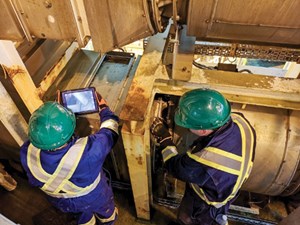
One example of the firm’s work occurred on a semisubmersible rig. “The contractor had a situation, where gas alarms in their shale shaker room would go off, and they couldn’t understand why their HVAC system was failed,” said Sooley. “They were actually prepared to do a whole pile of FEED work to install a whole new system. So, before doing that, they phoned us and asked if we could come out and survey the area, and see if something could be done with the existing system, which we did.”
“It turned out, their system was quite full of drilling mud,” continued Sooley. “So, we recommended removing the whole system and cleaning it. We removed 4,400 lbs of drilling mud from their system and duct work. We rebuilt their system, painted it, and made it as good as new. And we did all the airflow testing and calculations, and then sent off a very detailed report and graphical analysis. The client was impressed that we could save them so much money, and do it all in 13 days, with the majority done in-house.”
ACTIVITY UPDATE
As noted earlier, the NL E&P outlook looks optimistic through 2022. “Overall, we didn’t feel the effects of the downturn like Alberta or other jurisdictions did,” said Geoff Cunningham, V.P, Operations, at A. Harvey & Co. Ltd, which loads and services all the offshore supply boats in St. John’s Harbor. “All the companies’ projects continued. Overall, everyone kept drilling. The outlook here is very encouraging.”
Nalcor Energy—Oil & Gas. Since 2011, provincial energy firm Nalcor has conducted a massive seismic acquisition program of 2D and 3D data. This is part of Nalcor’s strategy of reducing risk to operators, while striving to increase exploration investment. In recent years, the program has netted some impressive independent resource estimates for tracts involved in licensing rounds during 2015, 2016 and 2018, Fig. 8. Thanks to Nalcor’s efforts, these three lease sales, combined, awarded 20 large tracts.
For November 2019, the licensing round, in conjunction with the Canada Newfoundland & Labrador Offshore Petroleum Board has two components, Fig. 9. The Southeastern Newfoundland frontier portion contains nine parcels covering 2.27 million hectares, south/southeast of the Jeanne d’Arc basin. “Here, the key risk in this licensing round is the presence of a petroleum system,” said Dr. Richard Wright, Nalcor’s exploration manager. “There were three wells drilled here historically, and all three were dry, and had no shows. So, we constructed a work program and did find a number of areas that demonstrated hydrocarbon presence. Ongoing work is assessing the potential for commercial-scale deposits.” The other half of the 2019 licensing round involves four parcels in the mature Jeanne d’Arc basin, covering about 465,000 hectares.
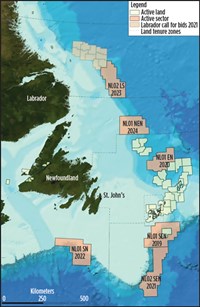
Husky. The West White Rose field development project is proceeding according to schedule, with the overall project approximately 40% complete. Craig Pardy, senior manager, Topsides, said, “We’ve got a number of sub-projects within the project. On the CGS, we did one major slip last year (Fig. 10), and have three scheduled for this year, leaving two for next year.”
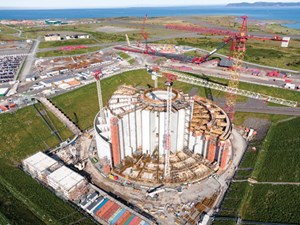
It should be noted that one of the world’s largest cranes, the AL.SK350, built by UK-based ALE, is working on the CGS construction at Argentia. It can lift up to 5,000 tonnes with a 124-m boom, and was put to work by Husky because of its immense reach.
Regarding a completion date for West White Rose, Pardy said, “right now, we’re working toward a 2022 total completion. Looking at the rest of the project, in Marystown—because that’s where we’re building the living quarters—we’re over 50% complete. And, if you look at the topsides in Ingleside, Texas, we’ve got all the main decks structurally fitted out, a lot of them welded out, some of them even painted. And the lower support frame—that’s been constructed and is on the skidway, and we’ll start to stack our decks on top of that later this year.”
As for fitting all the platform’s topsides pieces together, Pardy said, “The way it’s going to work is the living quarters and the appurtenances, the four items that I mentioned—the helideck, east and west lifeboat stations, and the flare boom—are going to be shipped down to Ingleside, we’ll integrate it all in Ingleside, and then the whole thing will be sent back to Newfoundland waters. There, it will be handed off to the Pioneering Spirit (the world’s largest construction vessel). The Pioneering Spirit will take it offshore and install it on top of the CGS.
ExxonMobil. At Noia’s annual meeting in June, ExxonMobil Canada Ltd. President Peter Larden provided an optimistic update on his firm’s activity. Larden said that Hibernia Management and Development Company Ltd. is producing roughly 120,000 bopd from its large platform at Hibernia (Fig. 11) field. ExxonMobil Canada is the lead owner of Hibernia. Yet, to grow production in the future, there will be a need for additional exploration to firm up prospects.
Larden told World Oil, “we need to right-size the regulatory review process, to ensure it remains robust and effective, but he remains pleased with ExxonMobil’s NL operations at present. “We’re at a really exciting point, in that we’ve got an exploration program this year. One well shortly, and one later on this year. And then on the development front, we’re looking at a range of potential subsea developments throughout our existing facilities (Hibernia and Hebron), which is always positive to capturing incremental reserves and looking to extend field lives.”
Larden emphasized that ExxonMobil is not necessarily in a pure exploration mode. “Hebron is still only 18 months, not even two years old yet, and so we’re still growing production,” he explained. “Currently, production is ahead of schedule, with down time at only 1.9%, which is really an industry-leading performance.”
Other operators are busy, as well. In June, Suncor and its partners officially sanctioned the Terra Nova Asset Life Extension (ALE) project. This upgrade project will extendTerra Novaoil field’s productive life for 10 years and capture roughly 80 MMbbl of additional oil. To complete the required upgrades, the Terra Nova FPSO will go offline for six to seven months in 2020, sailing to a drydock facility, where work will be executed. This work will complete enhancements to the vessel, to increase production capacity and efficiency, and to enable reliable operations over its extended life.
In late July, Equinor finalized a contract for the Transocean Barents, a harsh environment, ultra-deepwater rig, to carry out exploration drilling in the Flemish Pass basin next year. The semi-submersible will drill two new exploration wells, and also perform P&A activities on a previous well. Equinor said that this drilling does not relate directly to the potential, 300-MMbbl Bay du Nord field development in this area. “They’re expecting a decision maybe as early as the end of this year, but 2020 for sure, with hopefully first oil in 2025,” said CAPP’s Barnes. “And they’ve got an FPSO concept already in their minds.”
Meanwhile, BP won four exploration licenses in the Orphan basin, northeast of St. John’s, during the 2016 licensing round. The company has proposed to drill an initial exploration well in the area during 2020, subject to regulatory approval. Last, but not least, Australia’s BHP acquired two tracts in the Orphan basin during the 2018 licensing round. The firm announced in May 2019 that it intends to drill two wells in the area between July 2021 and July 2022.

- Coiled tubing drilling’s role in the energy transition (March 2024)
- Advancing offshore decarbonization through electrification of FPSOs (March 2024)
- The reserves replacement dilemma: Can intelligent digital technologies fill the supply gap? (March 2024)
- What's new in production (February 2024)
- Subsea technology- Corrosion monitoring: From failure to success (February 2024)
- Digital tool kit enhances real-time decision-making to improve drilling efficiency and performance (February 2024)
- Applying ultra-deep LWD resistivity technology successfully in a SAGD operation (May 2019)
- Adoption of wireless intelligent completions advances (May 2019)
- Majors double down as takeaway crunch eases (April 2019)
- What’s new in well logging and formation evaluation (April 2019)
- Qualification of a 20,000-psi subsea BOP: A collaborative approach (February 2019)
- ConocoPhillips’ Greg Leveille sees rapid trajectory of technical advancement continuing (February 2019)

